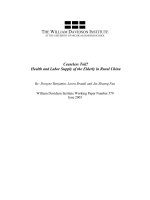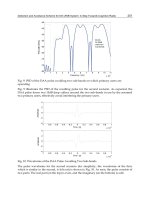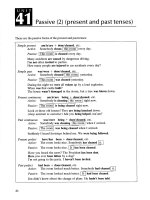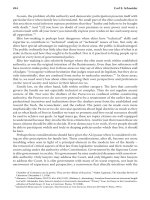The sat in exam 10 potx
Bạn đang xem bản rút gọn của tài liệu. Xem và tải ngay bản đầy đủ của tài liệu tại đây (79.15 KB, 6 trang )
of the critical genius he does not create. Any of
the other answer choices may be considered
true, but choice c is the only one found in this
passage, so it is the correct one.
11.e.The word colossal comes from the Latin colos-
sus and refers to a figure of gigantic propor-
tions. The author has been discussing Dante
and Michelangelo, both of whom he obviously
admires. So, when he calls Beethoven an artist
of the same order as those two, even if you
don’t know the word colossal, you can assume
he is complimenting Beethoven’s artistry.
12. b. In answering this question, it is important to
keep in mind the author’s purpose in writing
the passage—to praise poetical genius.
Beethoven is the sole composer discussed
along with other creative artists the author
reveres. While some of the other choices may
be true, the author does not discuss them in
this passage.
13. a. This is a question about the author’s main
point, or purpose in writing the passage. The
word suggests tells you the exact phrasing of
the answer choices may not be found in the
passage itself. The author is praising artistic,
or poetical genius and writes at length about
the artistic imagination. The only answer
choice that summarizes the author’s ideas is
choice a. Again, while some of the other
answers may be true, they are not found in the
passage.
14. d. In the first paragraph, Lincoln is discussing
two U.S. laws that are philosophically
opposed to each other: the fugitive-slave law,
which requires a runaway slave to be returned
to his or her owner, even if the slave has
escaped to a free state, and the law which for-
bids the importation of slaves into the coun-
try, a law aimed at curtailing the slave trade.
He says that each law is as well enforced as
any law can be when the community itself is
so divided on the moral issues involved. In
other words, someone who supports the
fugitive-slave law would be pro-slavery; and
someone who supports forbidding the foreign
slave trade would be opposed to slavery. The
only answer choice which correctly restates
what Lincoln says is d.
15. b. After Lincoln makes the declaration that sepa-
ration would make matters worse, he gives his
reasons in the next sentence. He says that each
side would grow more firmly entrenched in its
own position, a position the opposing side
finds offensive.
16. c. This question asks for the point of the entire
paragraph. Lincoln makes several points here,
and it’s up to you to tie them together into a
coherent whole. While each answer is partially
true, only choice c sums up Lincoln’s state-
ments throughout the paragraph.
17. b. The phrase domestic institutions is used in a
sense we find unfamiliar today. Both before
and after this phrase, however, Lincoln is dis-
cussing laws, and domestic institutions is used
as part of that discussion.
18. a. The key to the correct answer here lies in the
phrase worthy and patriotic citizens, used to
describe those who want to change the Con-
stitution. Lincoln goes on to say that he does
not object to the proposed amendment.
19. e. Lincoln opens his Second Inaugural Address
by saying there is less occasion for an extended
address than there was at his first inaugura-
tion. He continues by comparing the two
occasions, using the words then and now; and
saying that the first occasion (then) called for a
detailed statement, but that now, little that is
new could be presented.
20. c. After using the phrase insurgent agents, Lin-
coln says what these agents were doing—
seeking to dissolve the Union. In other words,
they were secessionists.
–THE SAT CRITICAL READING SECTION–
37
5658 SAT2006[03](fin).qx 11/21/05 6:42 PM Page 37
21. b. When Lincoln says that one side would make
war rather than let the nation survive, he is lay-
ing blame at the feet of the secessionists—in
other words, the South.
22. c. You have to carefully trace back through the
sentence to determine if it refers to a word or
phrase in that sentence. It does, in fact, refer to
the word interest. You have to go back for two
more sentences to discover that interest refers
to slaves, not to slavery itself. Nevertheless,
even if interest referred to slavery, the correct
answer would still be interest.
Paragraph-Length
Critical Reading
23. b. The passage briefly summarizes the main
effects of the Great Depression, including
record unemployment, bank closings, and
homelessness. Although it does not refer to
the early causes of the economic crisis, it does
explain what ruined small farms and further
deepened the Depression. Thus, this passage
would be an effective introduction to a discus-
sion of the causes and effects of the Great
Depression. The focus is clearly on the impact
of the crisis in America, so choice a is incor-
rect, and the passage covers many conse-
quences of the depression, not just
unemployment (choice d). There is no sugges-
tion that the author will propose a change in
how economic crises are handled (choice c) or
a mention of economic conditions today, so
choice e is also incorrect.
24. c. Lines 5–6 state that shantytowns were called
“Hoovervilles” because citizens blamed their
plight on the Hoover administration’s refusal
to offer assistance. This suggests that Hoover
didn’t handle homelessness effectively, but it
doesn’t comment on Hoover’s overall han-
dling of the crisis, so e is incorrect. According
to the sentence, Hoovervilles were shacks built
by the homeless, so it could not refer to a fed-
eral housing program (choice a) or a new kind
of social program (choice d). Choice b may be
true, but the passage does not directly support
this claim.
25. d. The sentence states that the severe drought and
economic crisis together ruined small farms, so
coupled most nearly means combined. None of
the other choices makes sense in the context of
the sentence.
26. e. From the context of the passage, it can be
deduced that immobilizes is synonymous with
incapacitates, because lines 2–4 explain that
the effects of venom include targeting the
muscle tissue and causing breathing
difficulties.
27. c. The second-to-last sentence (lines 4–5) intro-
duces the general idea that some venom has
curative properties. The last sentence (lines
5–6) illustrates this by providing a concrete
example of some venom’s curative properties.
The last sentence does not explain how medi-
cines are derived from snake venom (choice
a), nor is its purpose to show how evolution-
arily advanced snakes are (choice b) or that
Brazilian snake venom has more curative
properties than other snakes (choice d).
Although the final sentence does introduce the
idea that some venom is used to treat hyper-
tension, it does this to expand on the state-
ment made in the previous sentence, not
merely to introduce a new concept, as is incor-
rectly suggested by choice e.
28. d. The passage clearly introduces and discusses
one subject area of Aristotle’s many philo-
sophical musings: friendship. Choice a is
incorrect because the passage addresses one
topic covered by a particular philosopher, not
philosophy as a whole. While the passage does
call Aristotle a great thinker, its primary pur-
pose is not to prove this, making choice b
–THE SAT CRITICAL READING SECTION–
38
5658 SAT2006[03](fin).qx 11/21/05 6:42 PM Page 38
incorrect. While the passage does state that
human beings are motivated only to achieve
happiness and that friendship may be a reflec-
tion of self-love, the passage does not intend
to show that human beings are egoistical
hedonists, thus making choice c incorrect.
Choice e is incorrect because, although the
passage ends in a question, it does not aim to
leave the reader with an unanswered question,
but rather to extrapolate one of Aristotle’s
points on friendship.
29. c. According to Aristotle, someone in a perfect
friendship wants success for his friend.
Although choice a seems like the right choice,
the passage never defines what it means to be a
virtuous person, nor does it give any examples
of this kind of person. The same is true for
choice b. Although helping a friend get a job is
an unselfish act, the passage does not define or
exemplify an unselfish act. Choice d is illogi-
cal, and choice e is a concept that is never
addressed in the passage.
30. d. Context is a big clue here. The sentence before
(lines 8–9) introduces the idea that equally vir-
tuous people form perfect friendships. Line 9
uses the word however, which suggests a con-
trasting, or opposite idea to the one in the pre-
vious sentence.
31. e. According to Aristotle, befriending someone
simply because he or she provides you with
pleasure (in this example, a sense of humor) is
the definition of an imperfect friendship.
Choice a is incorrect—the example given pro-
vides no evidence that B is not a virtuous per-
son. Choice b is incorrect for similar reasons
to choice a. The example given provides no
evidence that A is virtuous. Again, there is no
evidence that either A or B is virtuous, so
choice c is incorrect. Choice d is incorrect
because, according to the passage, it is in an
imperfect friendship that one friend uses the
other for pleasure alone, not in a perfect one.
32. b. In the last sentence, the author attempts to
extrapolate for the reader one of Aristotle’s
points on friendships. Choice a is incorrect
because, although Aristotle says that every-
thing we do is to achieve the goal of happiness,
he never says that this is a selfish pursuit.
Although the last sentence is a question, its
purpose is not to leave the reader in a
quandary, but rather to pinpoint one of Aris-
totle’s positions on friendships; thus, c is
incorrect. Choice d is incorrect; the author is
not trying to justify anything with the last sen-
tence. Choice e is incorrect because the author
never focuses on Aristotle’s teachings being
complex—if anything, the author is trying to
clarify for the reader Aristotle’s thoughts on
friendship.
–THE SAT CRITICAL READING SECTION–
39
5658 SAT2006[03](fin).qx 11/21/05 6:42 PM Page 39
Part 1: Complete That
Sentence!
There will be approximately 19 sentence completion
questions on the SAT. You will find them in three of
the critical reading sections, and they make up a little
less than 40% of your total Critical Reading score.
Each of these questions takes the form of a sentence
that is missing either one or two words, represented
by blanks. You will have five answer choices, a–e, and
must determine which answer best completes the
sentence.
Sentence completions test two separate aspects of
your critical reading skills: your vocabulary and your
ability to follow the internal logic of sentences. These
sentences are often quite complex. Fortunately, there
are some strategies that will greatly increase your score
on these questions.
Vocabulary Rules
By now, you are surely working on your vocabulary.
You’ve seen that a good working vocabulary is a very
important asset on the critical reading portion of the
exam. Remember, the best way to learn vocabulary is
also the easiest: Make long lists of words you don’t
know and then break them down into short lists. Learn
a short list every day.
Tip
When working on your vocabulary, remember
to focus first on roots, prefixes, and suffixes.
You will be pleasantly surprised to see how
quickly learning these will increase the size of
your vocabulary!
News Flash!
Try working with flash cards. They’re easy to handle,
portable, and friend-friendly, so you can study with a
buddy. You and your friends can drill each other. If you
can make games out of learning vocabulary, studying
will be more fun; and you will learn more, too!
Tip
When you learn a new word, try to use it in
conversation as soon as possible. Use a word
three times, and it’s yours!
Sentence Detective
Deciphering some of those sentences on the SAT can
seem like an impossible mission, but like everything
else worth doing, it’s hard at first and gets easier as you
practice. There are some basic skills you need to
acquire, though. Think of yourself as a detective trying
to decode a secret message. Once you have the key to
the code, it’s easy to decipher the message. The follow-
ing sections will give you the keys you need to unlock
the meanings of even the most complex sentences. The
great thing is that these are master keys that can unlock
any and all sentences, including the many complex
sentences you will encounter in your college reading.
Sentence Structure
The single most important key to the meaning of a sen-
tence is its structure. The best and easiest way to deter-
mine sentence structure is to look at its punctuation.
Sentence completion questions always have one or
more commas or semicolons. The basic strategy is to
separate the sentence into units divided by punctua-
tion. Often, one of the units will be complete (without
a blank); then at least one unit will have one or two
blanks. The complete unit will tell you what the unit(s)
with a blank(s) (incomplete unit) needs to say. For
example, consider this sentence: After finding sacred
objects inside numerous Mayan caves, archaeologists have
begun to revise their opinion that the Maya used the
caves solely for functions.
–THE SAT CRITICAL READING SECTION–
40
5658 SAT2006[03](fin).qx 11/21/05 6:42 PM Page 40
5 Words a Day = SAT Success
When you divide this sentence into punctuation-
defined units, you have:
After finding sacred objects inside numerous
Mayan caves,
and
archaeologists have begun to revise their opinion
that the Maya used the caves solely for
functions.
The first unit, the unit without the blank, tells you that
the second unit has something to do with what hap-
pened 1) after finding sacred objects and 2) in Mayan
caves. The second unit, the one with a blank, tells you
that 1) archaeologists have begun to revise their opin-
ion and 2) their opinion (before being revised) was
that Mayan caves were used only (solely) for so
me kind
of function, or purpose. Your mission is to figure out
what goes in the blank, namely what kind of function
or purpose archaeologists used to think the caves were
exclusively used for.
Now you’re ready to use the first unit to illuminate
the second. If scientists used to think one thing until
they found sacred objects, it means they used to think
the caves were not used for sacred purposes. Now you
know you need to fill in the blank with a word that
means non-sacred, a word such as civic, secular, or non-
ceremonial. Your final step is to look at the answer
choices to find the one that matches the idea you have
formed about what needs to be in the blank(s).
Here’s an example of a question that doesn’t
divide neatly into a complete unit and an incomplete
unit. This question is taken from the pretest, and it has
a blank in each of its two units:
The famous daredevil was actually quite
by temperament, as illustrated by the
fact that he did not until he was two
years old.
The first unit is The famous daredevil was actually
quite by temperament. The word actually tells
us that there is something unexpected going on. If
actually were removed from the sentence, there would
be no way you could know what kind of words go in
the blanks. Actually is a clue word, one that points you
toward the meaning of the sentence. The famous dare-
devil actually had an unexpected kind of tempera-
ment. What kind of temperament would you expect a
famous daredevil to have? Adventurous, bold, daring,
right? So the word that goes in the first blank will be
one that has a contrasting relationship to that expected
temperament.
The second unit of the sentence, as illustrated by
the fact that he did not until he was two years old,
uses a phrase of comparison, as illustrated by, to let us
know that the word that goes in the blank should com-
plete the idea of the daredevil’s having a non-bold tem-
perament. Think of a synonym for “not bold.”Put it in
the first blank. Now read the sentence, using your word
in the first blank. Think of something that, if not done
before age two, would indicate that kind of tempera-
ment. Next, look at the answer choices for words sim-
ilar to the ones you chose. The answer to that question,
41
Try this:
1. Figure out how many days there are until you take the SAT.
2. Multiply that number by 5.
3. If you have 30 days until the exam, you can learn 150 new words, if you learn only 5 new words
each day!
5658 SAT2006[03](fin).qx 11/21/05 6:42 PM Page 41
you may recall, was careful perambulate. Even if you
didn’t know that to perambulate is to walk, or move
about on one’s own, you could be fairly confident that
you had the right answer because careful is such a good
choice.
A Clue for You
The second important skill you must master for sen-
tence completion questions is the ability to identify
key words and phrases. These are the words that most
help you decode the sentence. Think of them as clues
to a mystery. Among the most useful of these are the
words that enable you to identify the logical relation-
ship between the complete unit(s) of the sentence and
the incomplete unit(s). As in the preceding example,
sometimes you have to complete one portion of a two-
blank sentence before you can work on the logical rela-
tionship of another unit. There are three types of logical
relationships commonly expressed in sentence com-
pletion questions: contrast, comparison, and cause and
effect. These three relationships will help you succeed
on sentence completion questions.
Contrast
Words that logically signal a relationship of contrast
are words such as: though, although, however, despite,
but, and yet. Can you think of others? There are also
phrases that signal a contrast between the units of the
sentence, phrases such as on the other hand or on the
contrary. Try making a sentence using these words and
phrases. See how the two parts of your sentence
oppose each other. This is the logical relationship of
contrast, or opposition. No matter how complex a
sentence completion sentence seems at first glance,
when you see one of these words or phrases, you will
know you’re looking at a sentence that expresses one
thought in its complete unit and a contrasting thought
in the incomplete unit. First, you decipher the thought
in the complete unit, and then fill in the blank in the
incomplete unit with a word that expresses a contrast-
ing thought. For example:
Although the tiger is primarily a solitary beast, its
cousin the lion is a animal.
First, divide the sentence into two units, using
the punctuation to guide you. Now you have as the
first unit, Although the tiger is primarily a solitary beast,
and, its cousin the lion is a animal, as the sec-
ond unit. The first unit tells you by the use of the word
although that the second unit will express a relation-
ship of opposition or contrast. You can see that tigers
and lions are being contrasted. The word that goes in
the blank has to be an adjective that describes animal
in the way that solitary describes beast. Therefore, the
word that will contrast with the idea in the first unit is
in opposition to solitary. What is an antonym of soli-
tary? Solitary means alone. You might choose the
word social. Friendly, gregarious, or sociable are other
options, all meaning “not solitary.” Then you look for
the word in the answer choices that is a synonym of
the word you chose.
Comparison
There are two kinds of comparison relationships:
comparison by similarity and comparison by restate-
ment. Words that signal comparison are words such
as likewise, similarly, and and. Phrases that introduce
comparisons are just as, as as, for example, as
shown and as illustrated by. Words and phrases that
precede restatement are namely, in other words, in
fact, and that is. Relationships of logical comparison
are straightforward. The idea expressed in the com-
plete unit of the sentence is similar to or the same as
the idea that needs to be expressed in the incomplete
unit. When you know what the complete unit says,
you know what the incomplete unit needs to say—the
same thing, or very nearly so. Here’s an example of a
comparison sentence:
Until he went to military school, Foster never
stood up straight; as illustrated by his in
this photograph.
–THE SAT CRITICAL READING SECTION–
42
5658 SAT2006[03](fin).qx 11/21/05 6:42 PM Page 42









